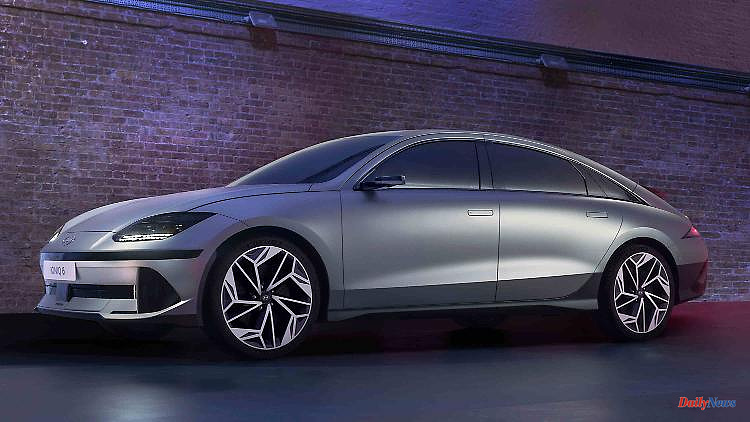Even after a model change, the members of a car family are usually very similar. Hyundai has now broken this rule of thumb and is really brushing the Ioniq's successor against the grain. Instead of corners and edges, there are now dynamic curves.
The Ioniq has had its day. Hyundai's range, launched in 2016, will disappear this summer. But not without a new vehicle coming onto the market under the same name and with the suffix 6. The Koreans have already provided insights into the design and interior of the future 800-volt electric vehicle in a prototype that is very close to the production status. Like the 5 introduced in 2021, the new Ioniq model also features a design that combines styles from bygone eras with what the designers call "retro-futuristic elements". However, the 6 does not create a clearly visible bridge to the sister model, but rather takes a clearly different direction. Even though the technology will be the same, the Ioniq 5 and 6 are very different types.
Hyundai already anticipated that the 6 will be different from the Ioniq in 2020 with the Prophecy study, for which design chief Peter Schreyer was responsible at the time. The aerodynamically designed sedan concept can also be found in the production model, albeit in a more pragmatic interpretation in many respects. It is not surprising that the series design is a bit more sober. But the consistent renunciation of references to the Ioniq is astounding. The 6 is clearly not a sedan version of the hatchback 5, but a statement in its own right. Hyundai's global design boss Sangyup Lee still speaks of an Ioniq family, whose members, however, can look very different, like the pieces in a chess game. Even if the king, queen, knight or bishop are clearly different from each other - the analogy to chess - they still form a strong team.
In this respect, there are of course similarities that should distinguish all future members of the Ioniq family. This includes a long wheelbase, due to the E-GM platform with a corresponding amount of space for passengers, an interior with sustainable materials and a cocoon effect, as well as parametric pixels in the front and rear areas.
As with the Ioniq 5, the small rectangular light elements also ensure a wow effect on the 6. The stub rear features a continuous strip of lights made up of two long rows of many small rectangles. An additional strip of light adorns the spoiler lip, while rear and fog lights arranged vertically are integrated into the diffuser-like rear apron. The theme of small luminous rectangles is also reflected in the headlights in the form of a daytime running light signature. The light design of the Ioniq 6 is not only concise, with the help of the many small light points there are also various possibilities for animated light sequences.
The outer skin is emphatically aerodynamic, with a roofline that curves in a large arc and extends well into the short rear rump. In addition, there are the door handles that are flush with the sheet metal skin and the small camera holders in the front doors, which serve as a streamlined replacement for the exterior mirrors. The reward for the effort is a drag coefficient of just 0.21. Compared to the edgy 5 with 0.29, the 6 has a clear advantage. Incidentally, it is noticeable that the 6 is less flat than the Prophecy at 1.50 meters and the door windows are not frameless. These are typical concessions to the red pen regime in mass production. The increase in height compared to the Prophecy is due to the battery construction in the vehicle floor being the same for all Ioniqs. If frameless doors should also make little wind noise on the motorway, according to Hyundai designer Simon Loasby, this will be disproportionately expensive for a volume model like the Ioniq 6.
At 4.86 meters, the 6 is over 20 centimeters longer than the 5, while its wheelbase of 2.95 meters is 5 centimeters shorter. Nevertheless, the scope for development in the Ioniq 6 remains generous at the front and rear. Despite the roof sloping towards the rear, the rear offers plenty of legroom as well as good headroom. On top of that, the 6 features a flat floor throughout and, in the optional four-seater version, a continuous center console. Among other things, the interior pleases with surfaces partly made of recycled plastic, with a tidy cockpit and a warm, homely atmosphere thanks to ambient lighting.
And then there are a few snazzy touches like translucent panels reminiscent of the first generation iMac. Another special feature are four light elements in the center of the steering wheel. They give visual feedback from voice recognition and also provide information about the charge level. Thanks to a 6-pixel display on the front of the vehicle, outsiders can also follow the charging progress.
And as befits a modern electric car, the cockpit offers two 12-inch displays on the dashboard in addition to the two optional monitors in the camera-based exterior mirrors. The left behind steering wheel mainly shows driving-related information, the touchscreen to the right is responsible for pretty much everything else.
For the time being, Hyundai says little about the technology of the Ioniq 6, which is expected to start at the turn of the year. But the E-GMP architecture with 800-volt technology sets tight limits in terms of drive, performance and battery. In this point, the 6 will be very similar to the Ioniq 5. The same should apply to the price, which could even be slightly lower than a comparably motorized Ioniq 5.












